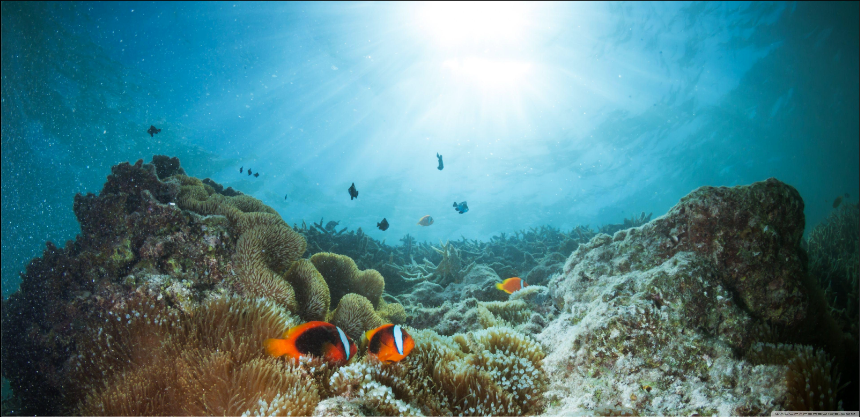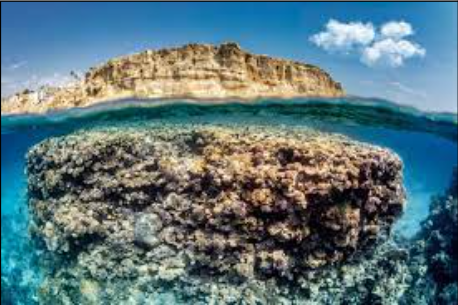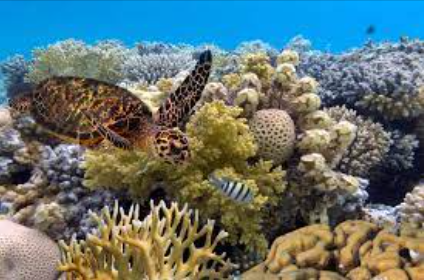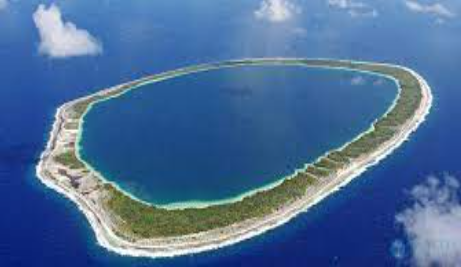
GS3- Environment
Coral reefs are underwater ecosystems formed by the accumulation and growth of coral polyps, which are tiny, soft-bodied organisms related to sea anemones and jellyfish. These reefs are known for their stunning biodiversity, vibrant colors, and unique ecological importance. Coral reefs play a crucial role in marine ecosystems, providing habitat and food for a wide variety of marine species.
Formation of Coral Reefs:
Coral reefs are formed over long periods of time through a process known as biomineralization or symbiotic association. Here's how it happens:
- Coral Polyps: Coral polyps are small, colonial organisms that secrete calcium carbonate (limestone) skeletons around their soft bodies. They feed on small plankton and capture calcium and carbonate ions from seawater to build their skeletons.
- Reef Building: Over time, these coral polyps create intricate structures by reproducing and building upon the limestone skeletons of their ancestors. These structures grow both vertically and horizontally.
- Symbiotic Algae: Many coral species have a mutualistic relationship with photosynthetic algae called zooxanthellae. The algae live within the coral tissues, providing the coral with essential nutrients through photosynthesis.
- Coral Growth: The growth of coral colonies continues as long as conditions are favorable, including warm water, sunlight, and appropriate nutrient levels.
Locations of Coral Reefs in India:
Coral reefs are found in several regions along the Indian coastline, including:
- Gulf of Kutch: Located in the northwestern part of India, the Gulf of Kutch has some coral formations, although they are not as extensive as those in other regions.
- Gulf of Mannar: Situated between Tamil Nadu and Sri Lanka, the Gulf of Mannar is home to some of the most diverse and well-preserved coral reefs in India.
- Andaman and Nicobar Islands: These islands in the Bay of Bengal have extensive coral reef systems, including fringing reefs, barrier reefs, and atolls.
Types of Coral Reefs: There are three main types of coral reefs:
- Fringing Reefs: These reefs grow close to the shore, often surrounding islands or coastal areas. They are the most common type of reef and are found in the Gulf of Mannar and around the Andaman and Nicobar Islands.

- Barrier Reefs: Barrier reefs are separated from the shore by a lagoon. They are typically found farther from the coast and can be quite large. The Great Barrier Reef in Australia is a famous example.

- Atolls: Atolls are circular or ring-shaped reefs that encircle a central lagoon. They are often formed on the submerged rims of ancient underwater volcanoes. The Lakshadweep Islands in India have atoll formations.

Coral reefs are delicate ecosystems vulnerable to environmental stressors such as pollution, rising sea temperatures, and ocean acidification. Conservation efforts are crucial to preserving these valuable marine habitats and the biodiversity they support.
Ideal Environmental Conditions for Coral Reefs:
Growing Conditions
Coral reefs thrive in specific environmental conditions that are crucial for their growth and survival:
- Warm Water Temperatures: Coral reefs are typically found in tropical and subtropical regions with warm water temperatures ranging from 20°C to 32°C (68°F to 89.6°F). They are sensitive to temperature fluctuations, and prolonged exposure to temperatures outside their optimal range can cause coral bleaching and death.
- Sunlight: Coral reefs require clear, shallow waters with ample sunlight penetration for photosynthesis to occur. The symbiotic algae (zooxanthellae) living within coral polyps need sunlight to produce energy and nutrients for the corals.
- Low Nutrient Levels: Coral reefs thrive in nutrient-poor waters. Excess nutrients from pollution, such as agricultural runoff or sewage, can lead to the overgrowth of algae, which competes with corals for space and resources.
- Stable Salinity: Fluctuations in salinity can stress coral polyps. Stable salinity levels are essential for the survival of coral reefs.
- Low Sedimentation: High levels of sediment in the water can smother corals and block sunlight. Healthy coral reefs are typically found in areas with low sedimentation rates.
- Calm Water Conditions: Coral polyps are delicate and can be damaged by strong wave action and currents. Protected areas or natural barriers, like barrier reefs and atolls, provide calmer conditions for coral growth.
Importance of Coral Reefs to Human and Marine Life:
The survival of coral reefs is vital for both human and marine life for several reasons:
- Biodiversity: Coral reefs are among the most diverse ecosystems on Earth, supporting an incredible variety of marine species. They hold one of the most diverse ecosystems in
- the world. It occurs less than 1% of the ocean and is the habitat of almost 25% of fish species that rely on reefs for shelter and breeding grounds, making them crucial for fisheries and food security.
- Coastal Protection: Healthy coral reefs act as natural barriers, protecting coastlines from erosion and the damaging effects of storm surges and waves. They reduce the impact of tropical storms and hurricanes on coastal communities.
- Tourism and Recreation: Coral reefs are major tourist attractions, generating significant revenue for coastal economies. Tourism activities such as diving and snorkeling provide jobs and income for local communities.
- Medicinal Compounds: Coral reefs are a potential source of pharmaceutical compounds with medicinal properties. Some coral species produce chemicals that may have applications in treating diseases.
- Climate Regulation: Coral reefs play a role in carbon and nitrogen cycling, helping to maintain a balanced marine ecosystem. They also absorb and store carbon dioxide, mitigating the effects of climate change.
- Cultural and Traditional Value: Many coastal communities have cultural and traditional ties to coral reefs, which play a central role in their way of life and cultural practices.
- Education and Scientific Research: Coral reefs are valuable for scientific research, helping us understand marine ecosystems, biodiversity, and climate change impacts. They serve as living laboratories for studying marine life.
Threats
The survival of coral reefs is threatened by human activities, including overfishing, pollution, coastal development, and climate change-induced factors such as coral bleaching and ocean acidification. Protecting and conserving these ecosystems is essential for the well-being of both marine ecosystems and the human communities that depend on them.
Coral reefs are facing numerous threats that are collectively contributing to their decline and potential extinction. These threats are often interconnected and include:
- Coral Bleaching: Elevated sea temperatures due to climate change can cause corals to expel the symbiotic algae (zooxanthellae) that live within their tissues. This loss of color and nutrients, known as coral bleaching, weakens corals and makes them more susceptible to disease and death.
- Ocean Acidification: The absorption of excess carbon dioxide by the oceans leads to a decrease in pH levels, making the water more acidic. This can hinder the ability of corals to build and maintain their calcium carbonate skeletons, making them more vulnerable to physical damage.
- Rising Sea Temperatures: Global warming leads to higher sea surface temperatures, which can trigger more frequent and severe coral bleaching events. Prolonged exposure to elevated temperatures can lead to mass coral mortality.
- Pollution: Runoff from agriculture, sewage, and coastal development introduces pollutants such as nutrients, sediment, and chemicals into coastal waters. These pollutants can smother corals, promote algal overgrowth, and contribute to disease outbreaks.
- Overfishing: Overfishing of herbivorous fish species that graze on algae can disrupt the natural balance of coral reef ecosystems. Algae overgrowth can outcompete corals for space and resources, leading to reef degradation.
- Destructive Fishing Practices: Certain fishing methods, such as blast fishing and cyanide fishing, directly damage coral reefs and the marine life they support. These practices are often illegal but still occur in some regions.
- Coastal Development: Coastal construction and urbanization can lead to habitat destruction, increased pollution, and sediment runoff, which can harm nearby coral reefs.
- Tourism Impact: Unsustainable tourism practices, including anchor damage, snorkeling and diving impacts, and the collection of coral and marine organisms, can damage reefs and disrupt their ecosystems.
- Invasive Species: Invasive species, such as the crown-of-thorns starfish, can prey on coral polyps and contribute to reef decline.
- Natural Disasters: Events like hurricanes, typhoons, and tsunamis can physically damage coral reefs and disrupt their ecosystems.
- Coral Disease: The increase in stressors on coral reefs can weaken corals, making them more susceptible to disease outbreaks.
- Local Stressors: Localized factors, including shipping traffic and boat anchoring, can physically damage coral reefs and contribute to their degradation.
International Regulations:
Several international regulations and agreements have been established to promote the protection and conservation of coral reefs and marine ecosystems. These agreements aim to address various threats to coral reefs and promote sustainable management practices. Some of the key international regulations and initiatives include:
- Convention on Biological Diversity (CBD): The CBD, adopted during the Earth Summit in 1992, recognizes the importance of conserving biodiversity, including coral reefs. Parties to the CBD have committed to protecting and conserving marine and coastal ecosystems, which encompass coral reefs.
- United Nations Framework Convention on Climate Change (UNFCCC): The UNFCCC, through agreements like the Paris Agreement, seeks to address climate change, a major threat to coral reefs due to rising sea temperatures and ocean acidification. Parties to the UNFCCC aim to reduce greenhouse gas emissions to mitigate climate change impacts on marine ecosystems.
- Ramsar Convention on Wetlands: The Ramsar Convention, which focuses on the conservation of wetlands, includes coral reefs and associated ecosystems as valuable coastal wetlands. Parties to the convention work to protect and manage these areas sustainably.
- World Heritage Convention: Several coral reef ecosystems are designated as UNESCO World Heritage Sites, such as the Great Barrier Reef in Australia and the Belize Barrier Reef. These designations come with special protections and management plans to safeguard these iconic reefs.
- International Coral Reef Initiative (ICRI): ICRI is a partnership of governments, international organizations, and non-governmental organizations dedicated to the preservation of coral reefs. It promotes the implementation of the ICRI Plan of Action and encourages the development of national and regional strategies for coral reef conservation.
- Regional Agreements: Various regional agreements and organizations, such as the Coral Triangle Initiative and the Caribbean Community (CARICOM), focus on coral reef conservation within specific regions. These agreements promote regional cooperation and conservation efforts.
- CITES (Convention on International Trade in Endangered Species of Wild Fauna and Flora): Some coral species are protected under CITES, which regulates international trade in endangered species. This helps prevent overharvesting of corals for the aquarium trade and jewelry industry.
- Sustainable Development Goals (SDGs): Goal 14 of the United Nations' SDGs focuses on the conservation and sustainable use of oceans, seas, and marine resources. Achieving this goal involves measures to protect and restore coral reefs.
- International Coral Reef Symposium (ICRS): The ICRS is a global conference that brings together scientists, policymakers, and conservationists to discuss the latest research and conservation efforts related to coral reefs
Steps taken by India
India has taken several steps to protect and conserve its coral reefs, which are found mainly in regions such as the Gulf of Mannar, the Gulf of Kutch, and the Andaman and Nicobar Islands. These steps include
- Marine Protected Areas (MPAs): India has established several Marine Protected Areas that include coral reef ecosystems. These areas are designated for the conservation of marine biodiversity, and activities such as fishing and tourism may be regulated to minimize their impact on the reefs. For example, the Gulf of Mannar Marine National Park and the Mahatma Gandhi Marine National Park in the Andaman and Nicobar Islands are MPAs with coral reef protection mandates.
- Coral Reef Monitoring: India conducts regular monitoring of coral reefs to assess their health and status. Scientific research and monitoring programs help identify threats, track changes, and inform conservation efforts.
- Conservation Awareness: Public awareness campaigns and educational programs are conducted to raise awareness about the importance of coral reefs and the need for their protection. These initiatives target local communities, tourists, and stakeholders.
- Legislation and Regulations: India has enacted laws and regulations to protect coral reefs and their associated marine life. The Wildlife Protection Act, of 1972, includes provisions for the protection of coral reefs and the prohibition of their collection and trade without proper permits.
- Integrated Coastal Zone Management (ICZM): The government has adopted Integrated Coastal Zone Management plans to address coastal zone issues comprehensively, including coral reef conservation. These plans aim to balance economic development with environmental protection.
- Research and Conservation Initiatives: India collaborates with international organizations and institutes on research and conservation initiatives related to coral reefs. These partnerships help leverage expertise and resources for conservation efforts.
- Coral Restoration Programs: Some organizations and research institutions in India are involved in coral restoration programs, including coral transplantation and coral farming. These efforts aim to restore damaged reef areas and enhance coral resilience.
- Dive Tourism Regulations: Regulations are in place to govern recreational diving and snorkeling activities around coral reefs to minimize physical damage and protect marine life.
- International Cooperation: India participates in international agreements and initiatives related to coral reef conservation, including those under the Convention on Biological Diversity (CBD) and the International Coral Reef Initiative (ICRI).
- Climate Change Mitigation: India is actively involved in global efforts to mitigate climate change, which includes reducing greenhouse gas emissions. Addressing climate change is crucial for the long-term survival of coral reefs.
Despite these efforts, coral reefs in India continue to face multiple threats, including rising sea temperatures, pollution, overfishing, and coastal development. Sustainable management practices, community engagement, and ongoing research are essential components of India's ongoing commitment to protect these valuable marine ecosystems.
Way Forward
- Sustainable Management: Implement and enforce sustainable management practices for coral reefs, including the establishment of well-managed marine protected areas, sustainable fishing practices, and strict regulations to reduce pollution and habitat destruction.
- Climate Action: Globally, work to reduce greenhouse gas emissions to mitigate the impacts of climate change on coral reefs. Locally, focus on initiatives to reduce stressors such as land-based pollution and sedimentation.
- Community Engagement: Involve local communities in coral reef conservation efforts. Support initiatives that empower communities to protect and manage reefs, recognizing their role as stewards of these ecosystems.
- Scientific Research: Continue research to understand coral reef ecosystems, their resilience mechanisms, and the best strategies for their restoration and conservation.
- Education and Awareness: Increase public awareness about the importance of coral reefs and the threats they face. Educate communities, tourists, and policymakers about the role they can play in conservation.
- International Cooperation: Collaborate with neighboring countries and international organizations to develop and implement regional strategies for coral reef protection. Share knowledge and resources to strengthen conservation efforts.
- Coral Restoration: Invest in coral restoration initiatives, including coral transplantation and coral farming, to rebuild damaged reef areas and enhance their ability to recover from stress events.
- Adaptive Management: Develop and implement adaptive management plans that allow for flexibility in response to changing environmental conditions and emerging threats.
Conclusion:
Coral reefs are invaluable marine ecosystems that support biodiversity, protect coastlines, and provide livelihoods to millions of people around the world. However, they face a multitude of threats, including climate change, pollution, overfishing, and habitat destruction. It is crucial that nations, communities, and individuals take immediate and sustained action to protect and conserve coral reefs.
Efforts to safeguard these fragile ecosystems should involve a combination of sustainable practices, climate mitigation, research, education, and community engagement. International cooperation is essential, as the health of coral reefs transcends national boundaries.
By working together, we can preserve these underwater wonders for future generations, ensuring that coral reefs continue to thrive and contribute to the health and well-being of our planet. The time to act is now to secure a sustainable future for coral reefs and the myriad of life they support.
